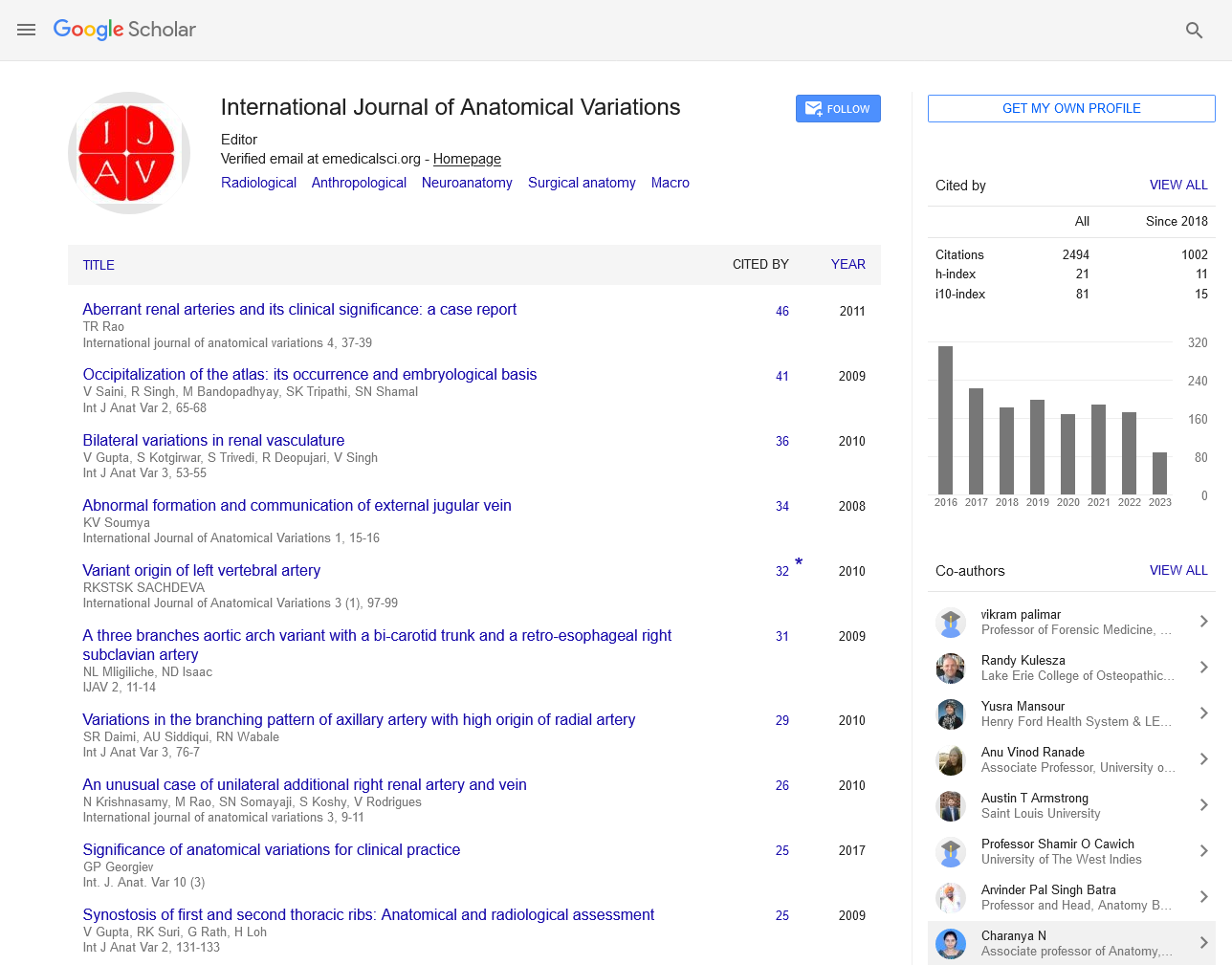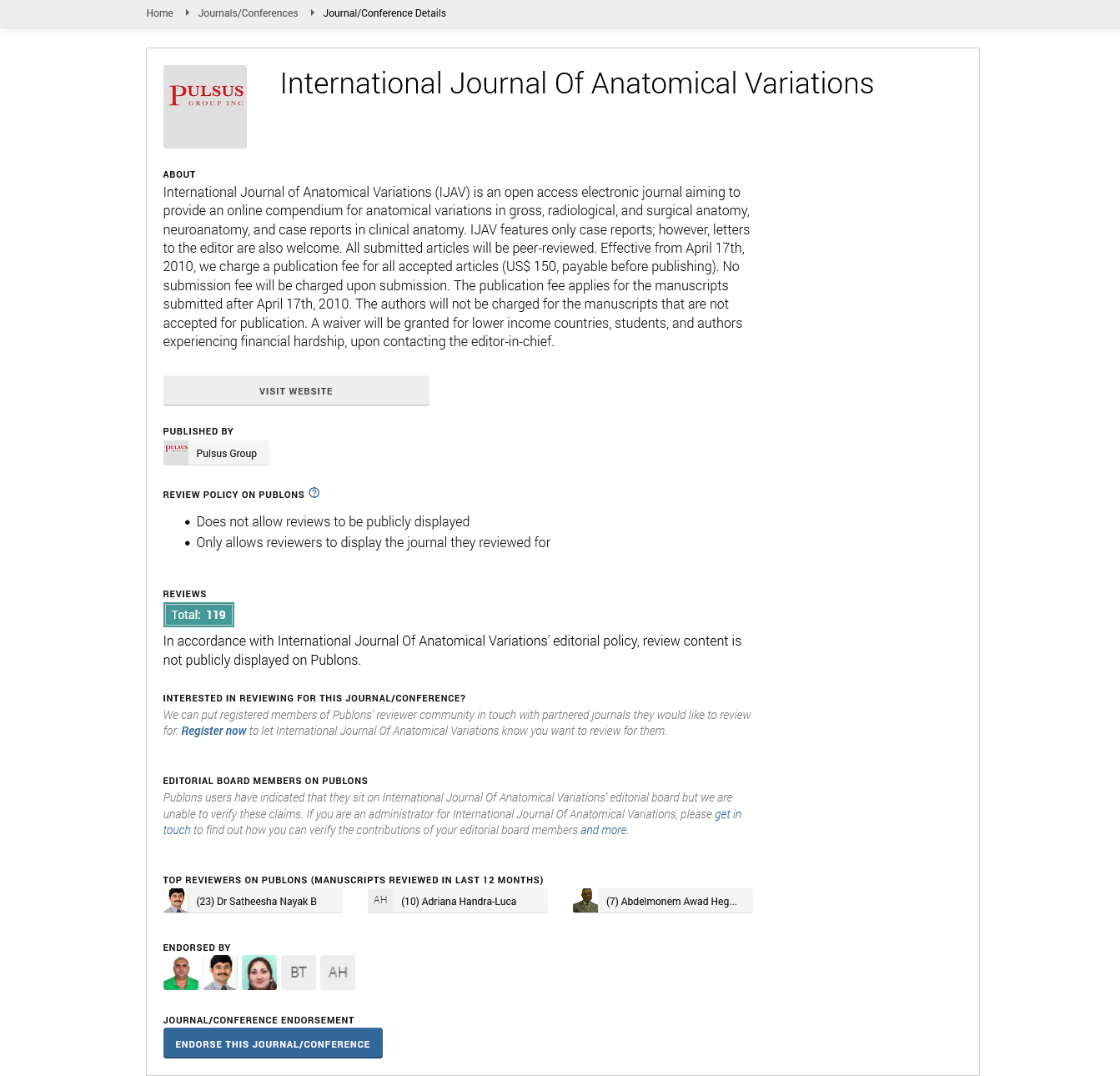The Spinal Cord Structure Function and Clinical Perspectives
Received: 01-Apr-2025, Manuscript No. ijav-25-7671; Editor assigned: 04-Apr-2025, Pre QC No. ijav-25-7671 (PQ); Reviewed: 21-Apr-2025 QC No. ijav-25-7671; Revised: 26-Apr-2025, Manuscript No. ijav-25-7671 (R); Published: 30-Apr-2025, DOI: 10.37532/13084038.18(4).505
Citation: Kumar R. The Spinal Cord Structure Function and Clinical Perspectives. Int J Anat Var. 2025; 18(4): 778-779.
This open-access article is distributed under the terms of the Creative Commons Attribution Non-Commercial License (CC BY-NC) (http://creativecommons.org/licenses/by-nc/4.0/), which permits reuse, distribution and reproduction of the article, provided that the original work is properly cited and the reuse is restricted to noncommercial purposes. For commercial reuse, contact reprints@pulsus.com
Abstract
The spinal cord is a vital structure within the central nervous system that serves as a conduit for sensory and motor information between the brain and the body. This article explores the anatomical and physiological properties of the spinal cord, its role in neural communication, common pathologies affecting it, diagnostic tools, and current treatment modalities. A comprehensive understanding of the spinal cord’s complexity is crucial for advancing neurological research and improving outcomes for patients with spinal cord injuries and diseases.
INTRODUCTION
The spinal cord is a cylindrical structure composed of nervous tissue that extends from the brainstem down through the vertebral column [1]. It plays a crucial role in transmitting neural signals and is responsible for various reflexes and motor functions. Understanding the spinal cord’s structure and function is key to treating spinal disorders and neurological conditions that impact quality of life. The spinal cord is a central component of the human nervous system, serving as the primary communication highway between the brain and the rest of the body. Encased within the protective vertebral column, it plays a crucial role in relaying sensory information to the brain and transmitting motor commands from the brain to peripheral tissues [2]. Beyond its role in signal transmission, the spinal cord is also responsible for coordinating numerous reflexes and maintaining autonomic functions essential for survival. Understanding the spinal cord's anatomy and physiology is foundational to neuroscience, medicine, and rehabilitation disciplines. Despite its relatively small size compared to the brain, the spinal cord exhibits remarkable complexity in its organization and function. It contains intricate networks of neurons and glial cells, arranged in distinct gray and white matter regions that facilitate both local processing and long-distance communication. From a clinical perspective, the spinal cord is vulnerable to a range of disorders, including traumatic injuries, degenerative diseases, infections, and congenital malformations. These conditions can result in profound neurological deficits, including paralysis [3], sensory loss, and autonomic dysfunction, significantly impacting a person's quality of life. Advances in imaging, electrophysiology, and molecular biology have improved our understanding of spinal cord pathology, leading to new diagnostic tools and therapeutic strategies. This article provides a comprehensive overview of the spinal cord, examining its structural and functional characteristics, common clinical disorders, and current approaches to diagnosis and treatment. By integrating anatomical knowledge with clinical insights, we aim to highlight the importance of the spinal cord in health and disease, and to underscore the need for continued research in this critical area of neuroscience.
ANATOMY OF THE SPINAL CORD
The spinal cord extends from the foramen magnum to the level of the first or second lumbar vertebra. It is segmented into cervical, thoracic, lumbar, sacral, and coccygeal regions. Each segment gives rise to spinal nerves that exit the vertebral column through intervertebral foramina. Internally, the spinal cord consists of gray matter [4], which contains neuron cell bodies, and white matter, made up of myelinated axons. The gray matter is organized into dorsal (sensory), ventral (motor), and lateral (autonomic) horns. White matter is divided into ascending (sensory) and descending (motor) tracts. The spinal cord is protected by three layers of meninges: dura mater, arachnoid mater, and pia mater. It receives blood supply from anterior and posterior spinal arteries and radicular arteries.
PHYSIOLOGY OF THE SPINAL CORD
The spinal cord is integral for transmitting signals between the brain and peripheral nerves. Ascending tracts carry sensory information, while descending tracts conduct motor commands. Spinal reflexes, such as the stretch reflex and withdrawal reflex, occur independently of the brain. These are mediated by local circuits in the spinal cord. The spinal cord houses neurons that are involved in the sympathetic and parasympathetic nervous systems, regulating functions like heart rate, digestion, and thermoregulation [5].
DISORDERS OF THE SPINAL CORD
Spinal cord injuries (SCI) from trauma can lead to partial or complete loss of motor and sensory function. The extent of damage depends on the location and severity of the injury. Conditions such as multiple sclerosis, amyotrophic lateral sclerosis (ALS), and spinal muscular atrophy affect the spinal cord’s function through neurodegeneration. Meningitis, transverse myelitis, and spinal abscesses can severely compromise spinal cord function. Spina bifida and tethered cord syndrome are examples of congenital defects that impact spinal cord development and function.
DIAGNOSTIC APPROACHES
MRI is the gold standard for spinal cord imaging, offering detailed views of soft tissues. CT scans and X-rays are used for assessing bony structures. Evoked potentials and electromyography can assess the functional status of spinal pathways.
FUTURE DIRECTIONS
Research into gene therapy, neuroregeneration, and neural interface technologies holds promise for reversing spinal cord damage and restoring function. Multidisciplinary approaches combining neurology, bioengineering, and regenerative medicine are key to advancing the field.
CONCLUSION
The spinal cord is a complex and essential structure with critical roles in sensory processing, motor control, and autonomic regulation. Continued research and innovation are vital to understanding spinal pathologies and improving treatment outcomes. Enhancing spinal cord health not only prevents disability but also fosters advances in neuroscience and rehabilitative medicine.
REFERENCES
- Fontana F, Coppola A, Ferrario L. Internal Iliac Artery Embolization within EVAR Procedure: Safety, Feasibility, and Outcome. J Clin Med. 2022; 11(24):73-99.
- Park K-M, Yang S-S, Kim Y-W, Park KB, Park HS, et al. Clinical outcomes after internal iliac artery embolization prior to endovascular aortic aneurysm repair. Surg Today 2014; 44:472-477.
- Rayt HS, Bown MJ, Lambert KV. Buttock claudication and erectile dysfunction after internal iliac artery embolization in patients prior to endovascular aortic aneurysm repair. Cardiovasc Intervent Radiol. 2008; 31(4):728-34.
- Patel SD, Perera A, Law N, Mandumula S. A novel approach to the management of a ruptured Type II endoleak following endovascular repair of an internal iliac artery aneurysm. Br J Radiol. 2011; 84(1008):e240-2.
- Szymczak M, Krupa P, Oszkinis G, Majchrzycki M. Gait pattern in patients with peripheral artery disease. BMC Geriatrics. 2018; 18:52.
Indexed at, Google Scholar, Crossref
Indexed at, Google Scholar, Crossref
Indexed at, Google Scholar, Crossref
Indexed at, Google Scholar, Crossref






